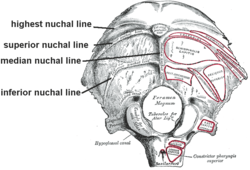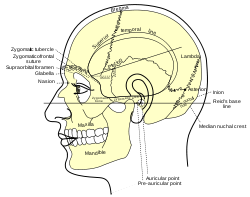Nuchal lines
Part of the skull's occipital bone From Wikipedia, the free encyclopedia
The nuchal lines are four curved lines on the external surface of the occipital bone:
- The upper, often faintly marked, is named the highest nuchal line, but is sometimes referred to as the Mempin line or linea suprema, and it attaches to the epicranial aponeurosis.
- Below the highest nuchal line is the superior nuchal line. To it is attached, the splenius capitis muscle, the trapezius muscle,[1] and the occipitalis.[2]
- From the external occipital protuberance a ridge or crest, the external occipital crest also called the median nuchal line, often faintly marked, descends to the foramen magnum, and affords attachment to the nuchal ligament.
- Running from the middle of this line is the inferior nuchal line. Attached are the obliquus capitis superior muscle, rectus capitis posterior major muscle, and rectus capitis posterior minor muscle.
| Nuchal lines | |
|---|---|
 Occipital bone. Outer surface. | |
 Side view of head, showing surface relations of bones. (Superior and median lines visible at bottom right.) | |
| Details | |
| Identifiers | |
| Latin | linea nuchae |
| Anatomical terms of bone | |
Additional images
- Posterior view of superior nuchal line (labeled in red) and muscles connecting to it.
References
External links
Wikiwand - on
Seamless Wikipedia browsing. On steroids.

